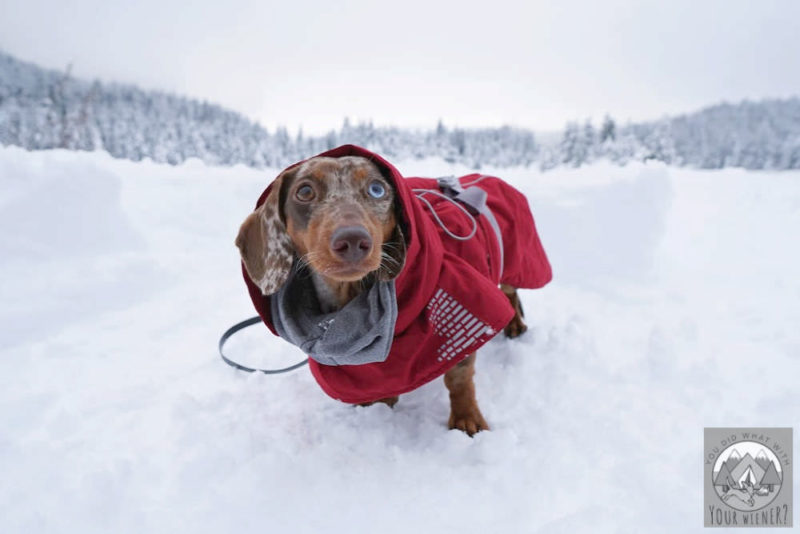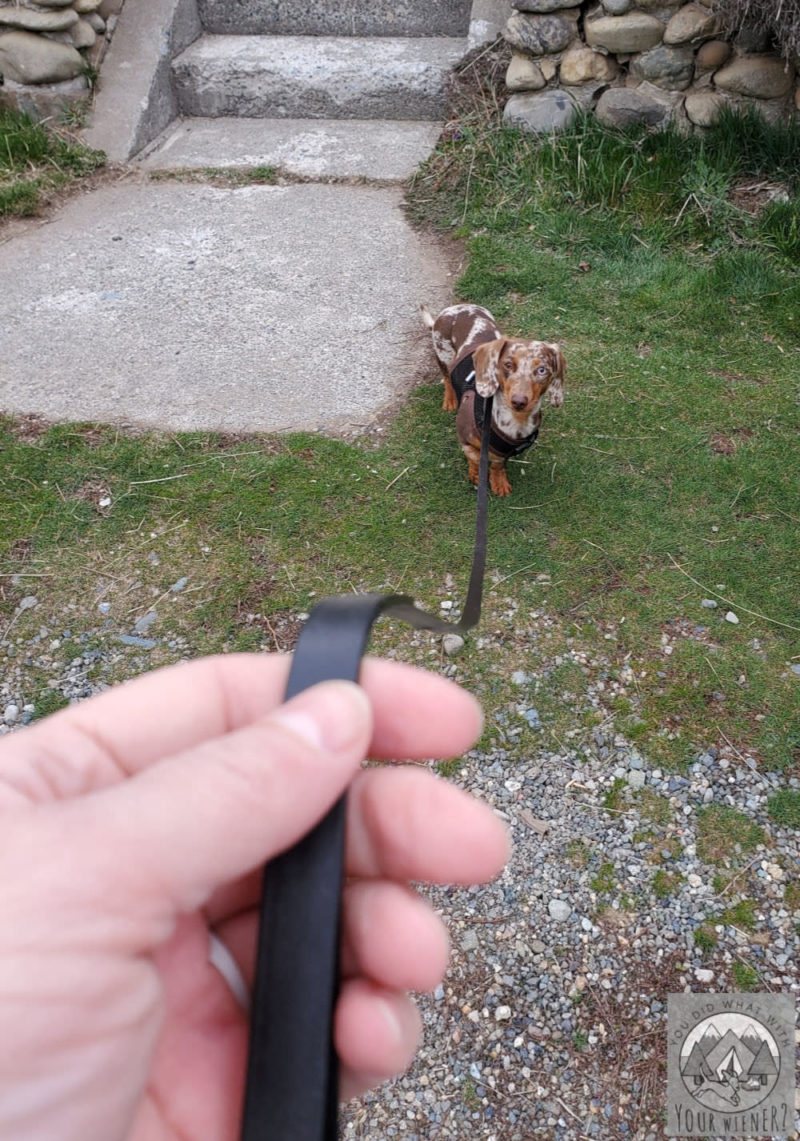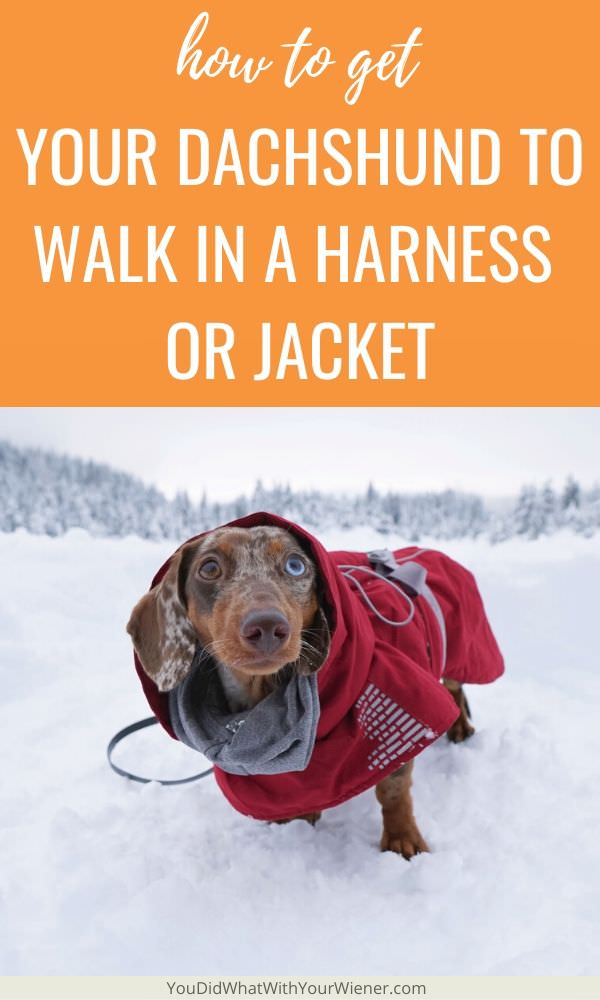How to Get Your Dachshund to Walk in a Harness or Jacket
There are many reasons a Dachshund may refuse to go for a walk.
Two of the most common scenarios I see are related to a harness or dog jacket.



If your Dachshund is used to walking on a collar, and you are trying to switch to a harness because you learned it’s safer your dog may not like the feeling of restriction or may feel weird walking because the harness touches their body in a different place.
The same goes for dog jackets. Dog jackets may be necessary to keep your Dachshund safe while walking or hiking in the cold but they can feel restrictive or weird to your dog if they are not used to them.
In either case, This new “contraption” can put pressure in a new place, be more constricting, hit their legs when they walk, etc., so your dog feels like something is “wrong”.
If your Dachshund is refusing to walk on a leash, the first thing you should do is consider these 12 reasons.
If you have determined that the issue is a harness or jacket, this article will help you and your dog get moving again.
I want to make an important note first though: I want to help you get your dog moving. There are many other more “advanced” issues that can come up that I am not addressing here.
A harness or jacket can feel strange and constricting to your Dachshund so it’s natural if they don’t want to walk in it at first.
Examples are pulling on a leash, barking and lunging on a leash, teaching a dog to “heel”, etc. You can find a lot of help on the internet with these things if you search for them.
Train Your Dachshund Puppy to Walk on a Harness and Leash
Puppies are born naked so it will take some effort for getting them used to wearing anything at all.
They will most likely freeze and refuse to move, act like you are trying to injure them, or cry out if you put a harness or jacket on them.
Also, they are used to moving about freely so the concept of being tethered to a leash is foreign to them and may freak them out.
Getting your Dachshund puppy to walk on a harness or leash simply comes down to proper training.
There are a lot of different training methods out there but this is what worked for me:
1) Train Your Dachshund puppy to not be afraid of putting the harness on.To see how to do that, watch this video and this video.
It’s natural for a puppy to resist any kind of clothing or harness. But with training, they can learn to accept or even enjoy wearing one (because they know it means fun is coming).
2) Put the harness on in the house and go about your normal business. The goal is to get your puppy to start walking around the house with the harness so they get used to the feel and learn that doing so is not, in fact, going to kill them.
3) Put the leash on in the house and have your puppy drag it around (under close supervision of course). This teaches your puppy to get used to the extra weight on their back and slight resistance.
4) Start walking your puppy on a leash around the house. You can either just tie the leash to your belt and have your puppy follow you around or practice walking back and forth in the living room.
5) Move exercises 2-4 to outside in the backyard. Dogs sometimes aren’t good at “generalizing” so your puppy may decide it’s ok to walk on a harness and leash in the house but go back to being freaked out once their surroundings change (ie. is outside).



6) When your puppy is old enough (had all their shots or you are comfortable with the risk), move to very short walks around your neighborhood. Make sure not to exercise your puppy too much while their bones and joints are still maturing.
Remember to keep training sessions short.
Keeping dog training sessions to under 10 minutes is always helpful but keeping them to 3-5 minutes each is better with puppies since they have a shorter attention span.
Training You Older Dachshund to Walk in a Harness or Jacket
How many times have you grabbed your Dachshund’s harness to put it on, turned around, and found them cowering under the table or bed?
If never, then you are fortunate. Your Dachshund already doesn’t have a problem with the harness so you can skip to the next step.
Just because your older Dachshund doesn’t like wearing a harness or jacket, doesn’t mean it always has to be that way.
If this describes your dog, then you will need to step back a little and train your dog to see the harness as a positive thing.
The method is the same as above (#1) with a puppy with two caveats.
One, if your older dog is already scared of the harness, it may take longer to get them happily wearing it than with a puppy who sees it as a new thing.
Second, reserve the regular harness you’re been using, if that is the one you want to continue using, as the one you will train with. Get a different harness for now that you will just put on despite your dog’s protest.
That way your Dachshund can start to associate the regular harness with good things.
In other words, this different harness is the one that will continue to be a bit “traumatizing” for them (at least for now) but that’s ok because eventually you will go back to using the one they’re becoming comfortable with.
The next steps after that, for an adult Dachshund, in my experience, comes down to ways to try and “trick” them into walking.



9 Ways to Out-Smart Your Dachshund into Walking
Besides my own Dachshunds, I used to walk several others as a dog walker.
For the Dachshunds that refused to walk, one of these 9 tricks almost always worked.
1) Switching directions. If your Dachshund refuses to walk the direction you want them to go, try surprising them by walking in the opposite direction. That is, of course, if the opposite direction is not back into the house.
2) Gently tug on the leash a couple of times and say “let’s go” or “come on” in a really excited voice. Dog trainers will advise against pulling on the leash but, personally, it’s worked for my Dachshunds and others.
3) Carry them to the end of the block and make them walk back to the house.
4) Try a new setting altogether by driving to a different location.
When a Dachshund refused to walk, especially when they have stopped at the same spot every time, changing the location can be enough to break them out of the habit.
5) Take them for a walk within the hour before meal-time. Most Dachshunds get a little spunky before dinner time and are more likely to walk then (especially back to the house where they know food awaits).
6) Bribe them with treats. Start with a treat just far enough in front of their nose that they have to take a couple steps forward. Gradually extend the distance they have to walk to be rewarded. Give them a lot of praise for doing so. Eventually, they may walk without the treats.
7) Go walking with a friend and their dog. Many Dachshunds like to be in front, or at least keep up, so they are more likely to walk with another dog leading the way.
8) Head into the woods. Forest trails are so much more interesting to a dog than city streets or sidewalks. There are so many more smells. A Dachshund’s hunting instinct is likely to kick in and they will become more interested in following smells than worrying about what they are wearing.
Sometimes, doing something really exciting can break the “I won’t go” cycle too. Chasing smells through the woods, or feeling like they are missing out on something fun, may be all the motivation they need to get going.
9) Be more exciting than just sitting there. Drop the leash and let them sit there in a safe place. If your Dachshund is not walking on leash for you, they are unlikely to move from that spot anyway. While keeping an eye on your dog, jog back and forth in front of them, acting like you are having the time of your life and saying “come on!” in an excited voice. Eventually, your dog may become curious and start to follow you and you can just pick up the leash.
Remember that not all of these tricks will work for every dog and not all of them will work with the same dog every time.
The key to success is to keep trying different things to figure out what works for yours.
It may take months for your puppy or adult Dachshund to be 100% comfortable walking on a harness or leash.
However, if you feel like you’ve tried everything without success, consider consulting with an animal behaviorist or dog trainer.
They can observe your situation, give you some insight into the reason your dog is hesitant to walk, and give you some specific advice to address the problem.
With time and patience, your Dachshund can become your best walking buddy.






About the Author
Hi, I’m Jessica. I’ve been studying the Dachshund breed since 2007, owned 3 of my own, and shared in the lives of thousands of others through their owner’s stories. When I’m not sharing what I know on this blog, you can find me hiking, camping, and traveling with my adventurous wiener dogs.

Great post. We have never had to much trouble and wonder if it is due to the senior Dachshund being excited and the younger ones not wanting to miss out.
That’s probably true
My Dachshund has a really hard time not pulling the leash and trying to chase cars! I think he was allowed to do this in his last home, but he is only 6 months. I’m trying to do 180s whenever he starts pulling but then he just anchors himself like a little stick. Any ideas?
Hi Ben. Without knowing what the underlying issue is causing the behavior, I’m afraid that I can only be of limited help. Does it only happen with cars? If it also happens with dog and people, it’s very likely general “reactivity:. This article I wrote on my other Dachshund blog may help: https://formydachshund.com/why-does-my-dachshund-bark-and-lunge-at-other-dogs-on-walks/. Turning to walk the other way is a good management” method but my suggestion there would be to turn around to walk the other way sooner if possible. It may be that your pup won’t be so resistant if you turn to walk away, say, 10 feet from the car instead of 5. You can also practice “heel” training or a command that means follow me (I use “this way!”). The training/obedience may override your dog’s desire to freak out on the car. Hope that helps some.
Hi Jessica! Thank you for this post! i am planning to travel with my doxie to a cold weather and I am searching for winter jackets. Can you please help me and recommend some brands or specific jackets? I love the one with the infinity-like scarf!
Hi Christina. There are many articles about recommended jackets on my post but this one is the “mother of them all” https://youdidwhatwithyourweiner.com/warm-coats-for-dachshunds-that-fit-their-long-body/